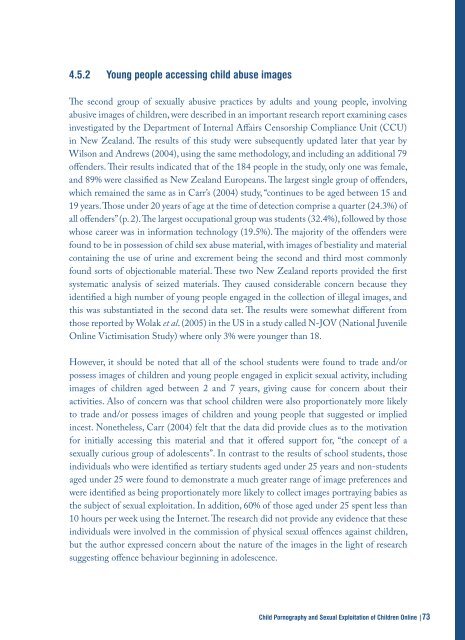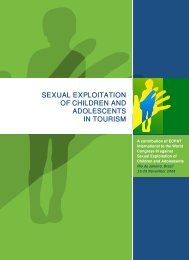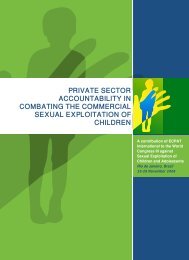to download the document in PDF format - Child Centre: Expert ...
to download the document in PDF format - Child Centre: Expert ...
to download the document in PDF format - Child Centre: Expert ...
You also want an ePaper? Increase the reach of your titles
YUMPU automatically turns print PDFs into web optimized ePapers that Google loves.
4.5.2 Young people access<strong>in</strong>g child abuse imagesThe second group of sexually abusive practices by adults and young people, <strong>in</strong>volv<strong>in</strong>gabusive images of children, were described <strong>in</strong> an important research report exam<strong>in</strong><strong>in</strong>g cases<strong>in</strong>vestigated by <strong>the</strong> Department of Internal Affairs Censorship Compliance Unit (CCU)<strong>in</strong> New Zealand. The results of this study were subsequently updated later that year byWilson and Andrews (2004), us<strong>in</strong>g <strong>the</strong> same methodology, and <strong>in</strong>clud<strong>in</strong>g an additional 79offenders. Their results <strong>in</strong>dicated that of <strong>the</strong> 184 people <strong>in</strong> <strong>the</strong> study, only one was female,and 89% were classified as New Zealand Europeans. The largest s<strong>in</strong>gle group of offenders,which rema<strong>in</strong>ed <strong>the</strong> same as <strong>in</strong> Carr’s (2004) study, “cont<strong>in</strong>ues <strong>to</strong> be aged between 15 and19 years. Those under 20 years of age at <strong>the</strong> time of detection comprise a quarter (24.3%) ofall offenders” (p. 2). The largest occupational group was students (32.4%), followed by thosewhose career was <strong>in</strong> <strong>in</strong><strong>format</strong>ion technology (19.5%). The majority of <strong>the</strong> offenders werefound <strong>to</strong> be <strong>in</strong> possession of child sex abuse material, with images of bestiality and materialconta<strong>in</strong><strong>in</strong>g <strong>the</strong> use of ur<strong>in</strong>e and excrement be<strong>in</strong>g <strong>the</strong> second and third most commonlyfound sorts of objectionable material. These two New Zealand reports provided <strong>the</strong> firstsystematic analysis of seized materials. They caused considerable concern because <strong>the</strong>yidentified a high number of young people engaged <strong>in</strong> <strong>the</strong> collection of illegal images, andthis was substantiated <strong>in</strong> <strong>the</strong> second data set. The results were somewhat different fromthose reported by Wolak et al. (2005) <strong>in</strong> <strong>the</strong> US <strong>in</strong> a study called N-JOV (National JuvenileOnl<strong>in</strong>e Victimisation Study) where only 3% were younger than 18.However, it should be noted that all of <strong>the</strong> school students were found <strong>to</strong> trade and/orpossess images of children and young people engaged <strong>in</strong> explicit sexual activity, <strong>in</strong>clud<strong>in</strong>gimages of children aged between 2 and 7 years, giv<strong>in</strong>g cause for concern about <strong>the</strong>iractivities. Also of concern was that school children were also proportionately more likely<strong>to</strong> trade and/or possess images of children and young people that suggested or implied<strong>in</strong>cest. None<strong>the</strong>less, Carr (2004) felt that <strong>the</strong> data did provide clues as <strong>to</strong> <strong>the</strong> motivationfor <strong>in</strong>itially access<strong>in</strong>g this material and that it offered support for, “<strong>the</strong> concept of asexually curious group of adolescents”. In contrast <strong>to</strong> <strong>the</strong> results of school students, those<strong>in</strong>dividuals who were identified as tertiary students aged under 25 years and non-studentsaged under 25 were found <strong>to</strong> demonstrate a much greater range of image preferences andwere identified as be<strong>in</strong>g proportionately more likely <strong>to</strong> collect images portray<strong>in</strong>g babies as<strong>the</strong> subject of sexual exploitation. In addition, 60% of those aged under 25 spent less than10 hours per week us<strong>in</strong>g <strong>the</strong> Internet. The research did not provide any evidence that <strong>the</strong>se<strong>in</strong>dividuals were <strong>in</strong>volved <strong>in</strong> <strong>the</strong> commission of physical sexual offences aga<strong>in</strong>st children,but <strong>the</strong> author expressed concern about <strong>the</strong> nature of <strong>the</strong> images <strong>in</strong> <strong>the</strong> light of researchsuggest<strong>in</strong>g offence behaviour beg<strong>in</strong>n<strong>in</strong>g <strong>in</strong> adolescence.<strong>Child</strong> Pornography and Sexual Exploitation of <strong>Child</strong>ren Onl<strong>in</strong>e |73




